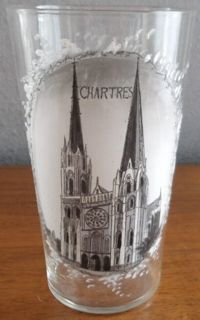

|
| FRANCE | FRANCE |
| région: Centre-Val de Loire | |
| département: 28, Eure-et-Loir |
Chartres is situated at an elevation of 142 m on the left bank of the river Eure in the French région Centre-Val de Loire, about 68&nbsk;northwest of Orléns, the regional capital. Chartres is the chef-lieu of the département Eure-e-Loir. The municipality has a population of about 38,400 (2021).
 Chartres was one of the principal towns in Gaul of the Carnutes, a Celtic tribe. In the Gallo-Roman period, it was called Autricum and afterwards
civitas Carnutum, "city of the Carnutes", from which Chartres got its name. The city was raided and burned down by the Norsemen in 858, and once again
besieged, this time unsuccessfully, by them in 911. During the Middle Ages, it was the most important town of the Beauce. It gave its name to a county that was
held by the counts of Blois, and the counts of Champagne, and afterwards by the House of Châtillon, a member of which sold it to the Crown in 1286. In
1417, during the Hundred Years' War, Chartres fell into the hands of the English, from whom it was recovered in 1432. In 1528, it was raised to the rank of a
duchy. In 1594, the cathedral of Chartres was the site of the coronation of Henry IV after he converted to the Catholic faith, the only king of France whose
coronation ceremony was not performed in Reims. In 1674, Chartres was raised from a duchy to a duchy peerage; the title of Duke of Chartres was hereditary in
the House of Orléans, and given to the eldest son of the Duke of Orléans. In World War II, the city suffered heavy damage by bombing and
during the battle of Chartres in August 1944, but its cathedral was spared by an American Army officer who challenged the order to destroy it.
Chartres was one of the principal towns in Gaul of the Carnutes, a Celtic tribe. In the Gallo-Roman period, it was called Autricum and afterwards
civitas Carnutum, "city of the Carnutes", from which Chartres got its name. The city was raided and burned down by the Norsemen in 858, and once again
besieged, this time unsuccessfully, by them in 911. During the Middle Ages, it was the most important town of the Beauce. It gave its name to a county that was
held by the counts of Blois, and the counts of Champagne, and afterwards by the House of Châtillon, a member of which sold it to the Crown in 1286. In
1417, during the Hundred Years' War, Chartres fell into the hands of the English, from whom it was recovered in 1432. In 1528, it was raised to the rank of a
duchy. In 1594, the cathedral of Chartres was the site of the coronation of Henry IV after he converted to the Catholic faith, the only king of France whose
coronation ceremony was not performed in Reims. In 1674, Chartres was raised from a duchy to a duchy peerage; the title of Duke of Chartres was hereditary in
the House of Orléans, and given to the eldest son of the Duke of Orléans. In World War II, the city suffered heavy damage by bombing and
during the battle of Chartres in August 1944, but its cathedral was spared by an American Army officer who challenged the order to destroy it.
 Chartres Cathedral (Cathédrale Notre-Dame de Chartres) is the seat of the Bishop of Chartres. Mostly constructed between
1194 and 1220, it stands on the site of at least five cathedrals that have occupied the site since the diocese of Chartres was formed as an episcopal see in
the 4th century. It is one of the best-known and most influential examples of High Gothic and Classic Gothic architecture. It stands on Romanesque
basements, while its north spire is more recent (1507–1513) and is built in the more ornate Flamboyant style. Since at least the 12th century the
cathedral has been an important destination for travellers. It attracts large numbers of Christian pilgrims, many of whom come to venerate its famous relic,
the 'Sancta Camisa', said to be the tunic worn by the Virgin Mary at Christ's birth. In 1908, the cathedral was given the papal title of a Basilica minor
(see list of basilicae minores, depicted on glasses of this collection). In 1979 the cathedral was listed as a
UNESCO World heritage Site (see list of UNESCO World Heritage Sites depictedon glasses of this collection).
Chartres Cathedral (Cathédrale Notre-Dame de Chartres) is the seat of the Bishop of Chartres. Mostly constructed between
1194 and 1220, it stands on the site of at least five cathedrals that have occupied the site since the diocese of Chartres was formed as an episcopal see in
the 4th century. It is one of the best-known and most influential examples of High Gothic and Classic Gothic architecture. It stands on Romanesque
basements, while its north spire is more recent (1507–1513) and is built in the more ornate Flamboyant style. Since at least the 12th century the
cathedral has been an important destination for travellers. It attracts large numbers of Christian pilgrims, many of whom come to venerate its famous relic,
the 'Sancta Camisa', said to be the tunic worn by the Virgin Mary at Christ's birth. In 1908, the cathedral was given the papal title of a Basilica minor
(see list of basilicae minores, depicted on glasses of this collection). In 1979 the cathedral was listed as a
UNESCO World heritage Site (see list of UNESCO World Heritage Sites depictedon glasses of this collection).
[https://de.wikipedia.org/wiki/Chartres, https://en.wikipedia.org/wiki/Chartres]
![[scale]](lineal.jpg)